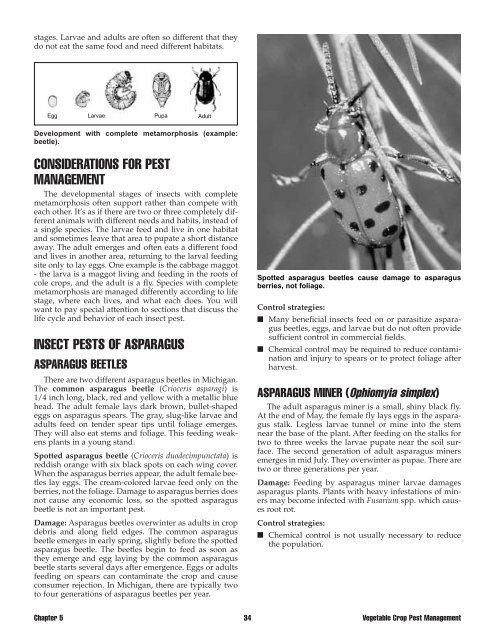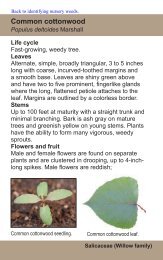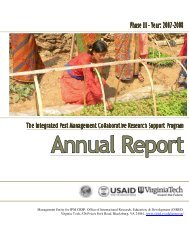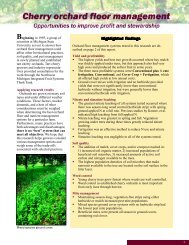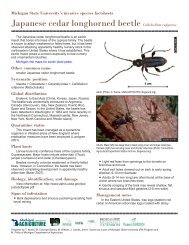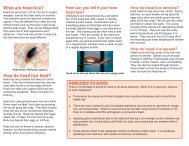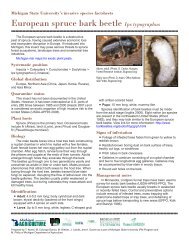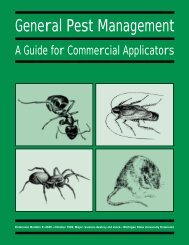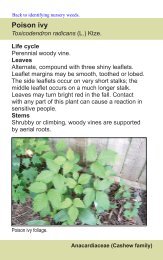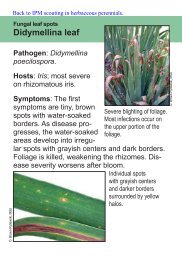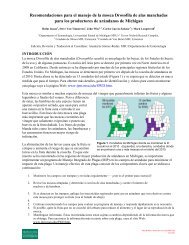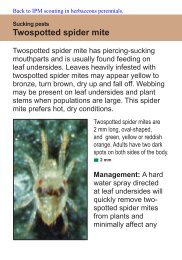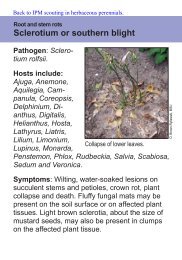Whole Manual - Michigan State University: Integrated Pest ...
Whole Manual - Michigan State University: Integrated Pest ...
Whole Manual - Michigan State University: Integrated Pest ...
You also want an ePaper? Increase the reach of your titles
YUMPU automatically turns print PDFs into web optimized ePapers that Google loves.
stages. Larvae and adults are often so different that they<br />
do not eat the same food and need different habitats.<br />
Egg Larvae Pupa Adult<br />
Development with complete metamorphosis (example:<br />
beetle).<br />
CONSIDERATIONS FOR PEST<br />
MANAGEMENT<br />
The developmental stages of insects with complete<br />
metamorphosis often support rather than compete with<br />
each other. It’s as if there are two or three completely different<br />
animals with different needs and habits, instead of<br />
a single species. The larvae feed and live in one habitat<br />
and sometimes leave that area to pupate a short distance<br />
away. The adult emerges and often eats a different food<br />
and lives in another area, returning to the larval feeding<br />
site only to lay eggs. One example is the cabbage maggot<br />
- the larva is a maggot living and feeding in the roots of<br />
cole crops, and the adult is a fly. Species with complete<br />
metamorphosis are managed differently according to life<br />
stage, where each lives, and what each does. You will<br />
want to pay special attention to sections that discuss the<br />
life cycle and behavior of each insect pest.<br />
INSECT PESTS OF ASPARAGUS<br />
ASPARAGUS BEETLES<br />
There are two different asparagus beetles in <strong>Michigan</strong>.<br />
The common asparagus beetle (Crioceris asparagi) is<br />
1/4 inch long, black, red and yellow with a metallic blue<br />
head. The adult female lays dark brown, bullet-shaped<br />
eggs on asparagus spears. The gray, slug-like larvae and<br />
adults feed on tender spear tips until foliage emerges.<br />
They will also eat stems and foliage. This feeding weakens<br />
plants in a young stand.<br />
Spotted asparagus beetle (Crioceris duodecimpunctata) is<br />
reddish orange with six black spots on each wing cover.<br />
When the asparagus berries appear, the adult female beetles<br />
lay eggs. The cream-colored larvae feed only on the<br />
berries, not the foliage. Damage to asparagus berries does<br />
not cause any economic loss, so the spotted asparagus<br />
beetle is not an important pest.<br />
Damage: Asparagus beetles overwinter as adults in crop<br />
debris and along field edges. The common asparagus<br />
beetle emerges in early spring, slightly before the spotted<br />
asparagus beetle. The beetles begin to feed as soon as<br />
they emerge and egg laying by the common asparagus<br />
beetle starts several days after emergence. Eggs or adults<br />
feeding on spears can contaminate the crop and cause<br />
consumer rejection. In <strong>Michigan</strong>, there are typically two<br />
to four generations of asparagus beetles per year.<br />
Spotted asparagus beetles cause damage to asparagus<br />
berries, not foliage.<br />
Control strategies:<br />
■ Many beneficial insects feed on or parasitize asparagus<br />
beetles, eggs, and larvae but do not often provide<br />
sufficient control in commercial fields.<br />
■ Chemical control may be required to reduce contamination<br />
and injury to spears or to protect foliage after<br />
harvest.<br />
ASPARAGUS MINER (Ophiomyia simplex)<br />
The adult asparagus miner is a small, shiny black fly.<br />
At the end of May, the female fly lays eggs in the asparagus<br />
stalk. Legless larvae tunnel or mine into the stem<br />
near the base of the plant. After feeding on the stalks for<br />
two to three weeks the larvae pupate near the soil surface.<br />
The second generation of adult asparagus miners<br />
emerges in mid July. They overwinter as pupae. There are<br />
two or three generations per year.<br />
Damage: Feeding by asparagus miner larvae damages<br />
asparagus plants. Plants with heavy infestations of miners<br />
may become infected with Fusarium spp. which causes<br />
root rot.<br />
Control strategies:<br />
■ Chemical control is not usually necessary to reduce<br />
the population.<br />
Chapter 5<br />
34<br />
Vegetable Crop <strong>Pest</strong> Management


